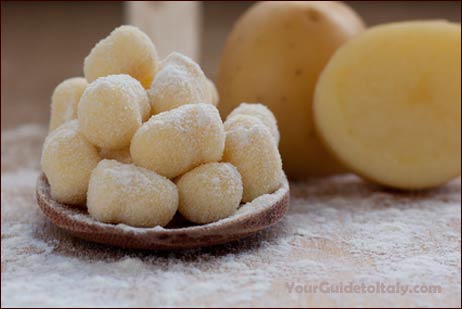Contrary to popular belief (among non-italians), achieving the right al dente cooking point is not so much a question of correct timing as it is of quality of the pasta. Some lower quality pasta made of wheat flour instead of durum semolina will never allow al dente cooking: it will either be too hard, or stick together.
Long shapes
Long shaped pasta is usually defined by the form obtained in cross section of the pasta.
- round and plain: capellini, spaghetti, spaghettoni;
- round and centrally perforated: bucatini, perciatelli, maccheroncelli, mezze zite, zite, zitoni, candele;
- flat, with rectangle or lenticular in cross section: bavette, linguine, tagliarelli, tagliarellini, fettuccine;
- indented or ondulating: ricciutelle, reginette.
Short shapes
- tube shapes with 'bill': maltagliati, penne, mostaccioli, maccheroni, pennette, pennini;
- tube shapes without 'bill': ditali, ditaloni, maniche, mezze maniche, bombolotti, rigatoni;
- twist shapes:
- elbows: chifferi, chifferotti, chifferoni, gramigna
- shell shapes: lumache, conchiglie, gnocchi, abissini
- specialty shapes: pisellini, piselli, puntine, puntette, risonem stelline, stellette, anellini, anelli, quadrucci, farfalline.
Filled pasta
Flavored pasta
Pasta in sheets or baking shapes
Pasta in this group is cut from larger sheets into various shapes that are used for baking pasta in the oven or used as long or short cuts served with sauce: lasagne, tagliatelle, pappardella, fettuccine, farfalle, farfalloni and cannelloni.
Pasta for soups and broths
Can be broadly divided into two groups: pasta for broths and pasta for minestrone soups.
.
.
.
.
Pasta is a generic term for noodles of various lengths, widths and shapes, either accompanied by a sauce or filled with other ingredients. Note that in Italian pasta is also the generic term for any kind of dough (bread, pizza), but it is usually made clear from the context what type of pasta one is referring to.
Most pasta is made from durum wheat semolina flour and water, with or without eggs and come in different shapes and colors. Pasta with eggs should contain at least five entire eggs for each kilogram of semolina. Only natural ingredients such as tomatoes, basil, spinach, truffles or cuttlefish ink may be added to color or flavor the dry pasta.
Are all pasta made from wheat products ?
No, true Gnocchi are not made of wheat, but of mashed potatoes. Nowadays you also find gnocchi as a form of wheat pasta, where the pasta is made of semolina but in the traditional gnocchi shape.
Dried or Fresh pasta?
Pasta can be bought dried or fresh. "Fresh" packed pasta has now also become more and more widespread. Fresh home-made pasta cooks very quickly and has a delicate taste, but spoils quickly due to its high water content. Dry pasta generally contains about 10% moisture, which makes it shelf stable for about three years. "Fresh" packed pasta, has a taste intermediate between fresh and dried pasta and has a shelf life of around 7 weeks. Many brands now also offer true italian pasta preparations in frozen form.
Home-made pasta is further divided according to the technique or instrument used to stretch or cut the pasta, such as ferro, torchietto, chitarra, or pettine. Spaghetti alla chitarra, for example, have a characteristic square shape because the dough is pressed through the cords of an instrument that reminds a guitar. Roughly speaking, these production techniques can be divided into extrusion-based methods, where the ingredients are forced through holes in a plate known as a die, or lamination-based methods, in which dough is kneaded, folded, rolled to thickness, then cut by slitters.
Dried Pasta
Trenette: Pesto
Rigatoni: Amatriciana, Carbonara
Spaghetti: Carbonara, Norma (egg plant and ricotta)
Chitarra: Tartufi (truflles), Vongole (clams)
Penne: Arrabbiata, Bolognese
Conchiglie: Tomato sauce
Cavatappi: Vegetarian sauce
Maccheroni: Tomato sauce
Fresh Pasta
Capellini: broth
Pappardelle: Cacciatora
Fettuccine: Funghi (mushrooms), pesto
Maltagliati: Funghi (mushrooms), meat-based sauce
Linguine: Vongole, allo Scoglio (seafood), pesto
Chitarra: Vongole
Filled Pasta
Agnolotti: meat-based sauce
Cappelletti: broth
Tortellini: Panna (cream-based sauces), Quattro formaggi (four cheeses)
Callelloni: filled with meat
Lasagne: with meat,vegetarian or fish





